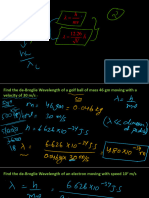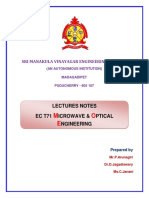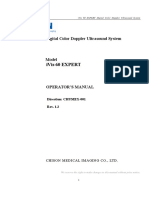Numerical Problems in Engineering Physics
1. Calculate the de Broglie wavelength of an electron moving with a velocity of 3 × 106 m/s.
2. What is the de Broglie wavelength of a proton moving with a velocity of 5 × 105 m/s?
3. A baseball has a mass of 0.145 kg and is moving with a velocity of 30 m/s. What is its de
Broglie wavelength?
4. Determine the de Broglie wavelength of an alpha particle (helium nucleus) traveling at a
speed of 2.0 × 107 m/s.
5. An electron is accelerated through a potential difference of 120 V. What is its de Broglie
wavelength?
6. Calculate the de Broglie wavelength of a neutron with a velocity of 1.5 × 106 m/s.
7. A car with a mass of 1000 kg is moving at a speed of 20 m/s. What is the de Broglie
wavelength of this car?
8. Determine the de Broglie wavelength of a photon with a frequency of 5 × 1014 Hz.
9. An alpha particle is emitted from a radioactive source with a kinetic energy of 5 MeV.
Calculate its de Broglie wavelength.
10. Calculate the de Broglie wavelength of a molecule of mass 2 × 10 -26 kg moving with a velocity
of 500 m/s.
11. Calculate the kinetic energy of an electron with a velocity of 2.5 × 106 m/s.
12. A proton is accelerated through a potential difference of 100 V. Determine its kinetic energy.
13. An alpha particle has a kinetic energy of 5 MeV. Calculate its velocity.
14. Determine the kinetic energy of a neutron moving with a velocity of 1.2 × 106 m/s.
15. Calculate the total energy (kinetic + potential) of an electron in an electric field with a
potential difference of 50 V.
16. An object with a mass of 0.02 kg is moving at a speed of 10 m/s. What is its kinetic energy?
17. Determine the kinetic energy of a photon with a frequency of 3 × 1015 Hz.
18. Calculate the total energy of a particle with a mass of 1.5 × 10-27 kg moving at a velocity of 4 ×
107 m/s.
19. A car with a mass of 1200 kg is moving at a velocity of 20 m/s. What is its kinetic energy?
20. An electron is accelerated through a potential difference of 500 V. Determine its kinetic
energy.
21. Calculate the minimum uncertainty in the position of a particle if its momentum is known to
be 1×10−25 kg⋅m/s.
22. A particle's position is known within a range of 0.01 nm. Calculate the minimum uncertainty
in its momentum.
23. If the uncertainty in the position of an electron is 2×10 −10 m, determine the minimum
uncertainty in its velocity.
24. Calculate the minimum uncertainty in the position of a car traveling at 30 m/s if its
momentum is known to be 500 kg⋅m/s.
25. An atom's velocity has an uncertainty of 1000 m/s. Determine the minimum uncertainty in
its position.
26. If the uncertainty in the position of a particle is 5×10 −12 m, find the minimum uncertainty in
its momentum.
27. Calculate the minimum uncertainty in the position of an electron if its velocity is known to be
2×106 m/s.
�28. A particle's momentum has an uncertainty of 1×10 −22 kg⋅m/s. Determine the minimum
uncertainty in its position.
29. If the uncertainty in the position of a photon is 1×10 −9 m, find the minimum uncertainty in its
wavelength.
30. An electron's position is known within a range of 0.05 nm. Calculate the minimum
uncertainty in its kinetic energy.
31. Calculate the energy of a photon with a wavelength of 500 nm.
32. Determine the energy of a photon with a frequency of 5×1014 Hz.
33. A photon has an energy of 2×10−18 J. What is its wavelength?
34. Calculate the energy of a gamma-ray photon with a frequency of 3×1019 Hz.
35. Determine the energy of a photon with a wavelength of 400 nm.
36. A photon has an energy of 4×10−21 J. What is its frequency?
37. Calculate the energy of an X-ray photon with a wavelength of 10 pm.
38. Determine the energy of a photon with a frequency of 2×1015 Hz.
39. A photon has an energy of 6.63×10−20 J. What is its wavelength?
40. Calculate the energy of a photon with a wavelength of 700 nm.
41. Calculate the interplanar spacing of a crystal lattice with Miller indices (1, 1, 1) and a lattice
constant of 4A˚.
42. Determine the interplanar spacing of a crystal with Miller indices (2, 1, 0) and a lattice
constant of 3A˚.
43. Calculate the interplanar spacing of a crystal lattice with Miller indices (1, 0, 0) and a lattice
constant of 5A˚.
44. Determine the interplanar spacing of a crystal with Miller indices (1, 1, 2) and a lattice
constant of 4A˚.
45. Calculate the interplanar spacing of a crystal lattice with Miller indices (3, 1, 0) and a lattice
constant of 6A˚.
46. Determine the interplanar spacing of a crystal with Miller indices (2, 2, 2) and a lattice
constant of 7A˚.
47. Calculate the interplanar spacing of a crystal lattice with Miller indices (1, 2, 3) and a lattice
constant of 8A˚.
48. Determine the interplanar spacing of a crystal with Miller indices (3, 2, 1) and a lattice
constant of 5A˚.
49. Calculate the interplanar spacing of a crystal lattice with Miller indices (2, 1, 2) and a lattice
constant of 9A˚.
50. Determine the interplanar spacing of a crystal with Miller indices (1, 2, 2) and a lattice
constant of 6A˚.
51. A fiber optic cable has a numerical aperture (NA) of 0.4. Calculate the acceptance angle (θ) in
degrees.
52. A light ray enters a fiber optic cable at an angle of 20 degrees with respect to the normal.
Determine whether this ray will be accepted by a fiber optic cable with an acceptance angle
of 30 degrees.
53. If a fiber optic cable has an acceptance angle of 45 degrees and a core diameter of 50 µm,
calculate the maximum angle at which a light ray can enter the cable.
54. A fiber optic cable has a numerical aperture of 0.3. What is the maximum angle at which
light can enter the cable if it has a core diameter of 100 µm?
55. If the acceptance angle of a fiber optic cable is 60 degrees and the refractive index of the
core material is 1.5, calculate the numerical aperture (NA) of the cable.
�56. Determine the acceptance angle of a fiber optic cable with a numerical aperture of 0.5 and a
core refractive index of 1.6.
57. A light ray enters a fiber optic cable with an angle of incidence of 40 degrees. If the cable has
an acceptance angle of 30 degrees, will the ray be accepted by the cable?
58. Calculate the numerical aperture (NA) of a fiber optic cable with an acceptance angle of 20
degrees and a core refractive index of 1.52.
59. A fiber optic cable with a numerical aperture of 0.35 is used for transmitting light. If the cable
has a core diameter of 75 µm, calculate the acceptance angle of the cable.
60. Determine the core diameter of a fiber optic cable required to achieve an acceptance angle
of 45 degrees, given that the cable has a numerical aperture of 0.25.
61. A fiber optic cable has a numerical aperture (NA) of 0.4. Calculate the acceptance angle (θ) in
degrees.
62. A light ray enters a fiber optic cable at an angle of 20 degrees with respect to the normal.
Determine whether this ray will be accepted by a fiber optic cable with an acceptance angle
of 30 degrees.
63. If a fiber optic cable has an acceptance angle of 45 degrees and a core diameter of 50 µm,
calculate the maximum angle at which a light ray can enter the cable.
64. A fiber optic cable has a numerical aperture of 0.3. What is the maximum angle at which
light can enter the cable if it has a core diameter of 100 µm?
65. If the acceptance angle of a fiber optic cable is 60 degrees and the refractive index of the
core material is 1.5, calculate the numerical aperture (NA) of the cable.
66. Determine the acceptance angle of a fiber optic cable with a numerical aperture of 0.5 and a
core refractive index of 1.6.
67. A light ray enters a fiber optic cable with an angle of incidence of 40 degrees. If the cable has
an acceptance angle of 30 degrees, will the ray be accepted by the cable?
68. Calculate the numerical aperture (NA) of a fiber optic cable with an acceptance angle of 20
degrees and a core refractive index of 1.52.
69. A fiber optic cable with a numerical aperture of 0.35 is used for transmitting light. If the cable
has a core diameter of 75 µm, calculate the acceptance angle of the cable.
70. Determine the core diameter of a fiber optic cable required to achieve an acceptance angle
of 45 degrees, given that the cable has a numerical aperture of 0.25.
71. A fiber optic cable has a numerical aperture (NA) of 0.4. Calculate the acceptance angle (θ) in
degrees.
72. A light ray enters a fiber optic cable at an angle of 20 degrees with respect to the normal.
Determine whether this ray will be accepted by a fiber optic cable with an acceptance angle
of 30 degrees.
73. If a fiber optic cable has an acceptance angle of 45 degrees and a core diameter of 50 µm,
calculate the maximum angle at which a light ray can enter the cable.
74. A fiber optic cable has a numerical aperture of 0.3. What is the maximum angle at which
light can enter the cable if it has a core diameter of 100 µm?
75. If the acceptance angle of a fiber optic cable is 60 degrees and the refractive index of the
core material is 1.5, calculate the numerical aperture (NA) of the cable.
76. Determine the acceptance angle of a fiber optic cable with a numerical aperture of 0.5 and a
core refractive index of 1.6.
77. A light ray enters a fiber optic cable with an angle of incidence of 40 degrees. If the cable has
an acceptance angle of 30 degrees, will the ray be accepted by the cable?
78. Calculate the numerical aperture (NA) of a fiber optic cable with an acceptance angle of 20
degrees and a core refractive index of 1.52.
�79. A fiber optic cable with a numerical aperture of 0.35 is used for transmitting light. If the cable
has a core diameter of 75 µm, calculate the acceptance angle of the cable.
80. Determine the core diameter of a fiber optic cable required to achieve an acceptance angle
of 45 degrees, given that the cable has a numerical aperture of 0.25.
81. A single-mode fiber optic cable has an attenuation coefficient of 0.2 dB/km. Calculate the
attenuation loss for a transmission distance of 10 km.
82. Determine the attenuation loss for a multimode fiber optic cable with an attenuation
coefficient of 0.5 dB/km over a transmission distance of 20 km.
83. Calculate the total attenuation loss for a fiber optic link consisting of two segments: one
segment of single-mode fiber with an attenuation coefficient of 0.3 dB/km over 15 km,
followed by a segment of multimode fiber with an attenuation coefficient of 0.7 dB/km over
10 km.
84. An optical fiber link has a total attenuation loss of 8 dB. If the fiber optic cable used has an
attenuation coefficient of 0.4 dB/km, determine the transmission distance.
85. A fiber optic cable has an attenuation coefficient of 0.25 dB/km. What is the attenuation loss
for transmitting a signal over a distance of 30 km?
86. Calculate the total attenuation loss for a fiber optic link consisting of three segments: one
segment of single-mode fiber with an attenuation coefficient of 0.5 dB/km over 10 km,
followed by a segment of multimode fiber with an attenuation coefficient of 0.6 dB/km over
15 km, and finally another segment of single-mode fiber with an attenuation coefficient of
0.3 dB/km over 20 km.
87. Determine the attenuation loss for a multimode fiber optic cable with an attenuation
coefficient of 0.8 dB/km over a transmission distance of 25 km.
88. An optical fiber link has a total attenuation loss of 12 dB. If the fiber optic cable used has an
attenuation coefficient of 0.6 dB/km, calculate the transmission distance.
89. Calculate the total attenuation loss for a fiber optic link consisting of two segments: one
segment of multimode fiber with an attenuation coefficient of 0.4 dB/km over 12 km,
followed by a segment of single-mode fiber with an attenuation coefficient of 0.2 dB/km
over 18 km.
90. Determine the attenuation loss for a single-mode fiber optic cable with an attenuation
coefficient of 0.1 dB/km over a transmission distance of 40 km.





















































































